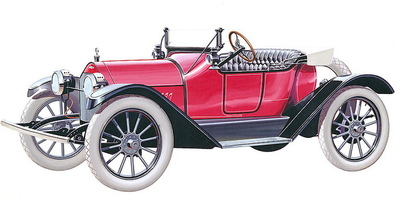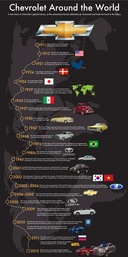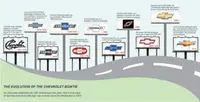100 Years of Chevrolet
 1914 Chevrolet Royal Mail sporting Chevrolet’s brand-new bowtie emblem, the $750 Series H “Royal Mail” roadster for 1914 was a spirited and affordable 4-cylinder car that appealed to young buyers. |
SEE ALSO: 1997-2020 Chevrolet Reviews, Specs, Comparisons Prices and Images - Chevrolet Buyers Guide
SEE ALSO: Chevrolet Content Archive 1995-Present
Swiss-Born racer Louis Chevrolet and American industrialist Billy Durant created Chevrolet Motors a global automotive icon.
Detroit MI October 31, 2011; “In 2010, Chevrolet sold a record 4.26 million cars and trucks globally, making it the fourth largest automotive brand in terms of worldwide sales,” said Chris Perry, vice president, global marketing and strategy for Chevrolet. “And the pace is accelerating—with 3.6 million Chevrolets sold globally during the first nine months of 2011—Chevrolet’s Centennial year is on track to be our best yet despite global economic uncertainty.”
1890 – 1930: Chevrolet Global Sales Begin
 Louis Chevrolet |
In 1922, future General Motors president William S. Knudsen moved into management at Chevrolet. He encouraged the development of GM plants on other continents to assemble vehicle “kits” manufactured in North America. The first such plant was established in Copenhagen completed its first Chevrolet on Jan. 7, 1924. By 1929, there were 18 “overseas” assembly plants turning out Chevrolets in Europe, South America, South Africa, Java (now part of Indonesia), Australia and New Zealand. Chevrolet assembly operations in Poland and India began in 1928.
The Chevrolet “bowtie” badge was introduced into Asian markets during the 1920s. A dealer was appointed in the Chinese city now known as Xiamen in 1921. Chevrolets were assembled in Japan from 1926 to 1941.
Although designed primarily for North American buyers, the Chevrolet passenger car of the 1920s was well established in global markets by the end of that decade. However, GM management had by then realized that smaller cars could eventually dominate the global auto market. They considered introducing a modified Chevrolet car with a smaller engine to reduce the burden of displacement-based import taxes but settled on having recently acquired Vauxhall of England and Opel of Germany produce smaller European cars for their home markets and export. This decision would drive GM global small car production for decades.
1930 – 1975: Chevrolet Establishes Global Footprint
Chevrolet sales fell as dire economic conditions plagued the world during the first half of the 1930s and rising economic nationalism in some markets resulted in sales quotas that further curtailed sales. On a brighter note, in 1935, ground was broken for an assembly plant in Mexico, a facility that would strengthen the enduring bond between that nation’s citizens and the bowtie brand. By 1937, Chevrolet export sales had rebounded and set a pre-World War II record of 368,000 cars and trucks shipped complete or in kits from North America. When WWII became a global conflict in 1941, the export of Chevrolets for civilian use was halted for the duration of the war.
After peace was declared in 1945, much of the world endured a protracted economic struggle to recover from the war. At the same time, American automakers raced to keep up with domestic post-war demand for new cars. Over time, the export of Chevrolet cars and trucks gradually resumed. The stylish American Chevrolets of the 1950s were coveted worldwide, although import taxes and their relatively large size made them prestige models in many nations.
In the late 1950s, a fledgling U.S. demand for small cars, mostly of European origin, suddenly surged. The initial popularity of these early “imports” spurred American car companies, including Chevrolet, to introduce smaller vehicle lines alongside their traditional full-size offerings.
The compact Chevy II (later renamed Nova) was introduced in the United States for 1962. Later that year, when a “Chevrolet 400” version went into production in Argentina, the Chevy II became the first small car designed and engineered by Chevrolet to be produced in an international variant.
South America had long been a bastion of Chevrolet’s international strength by the time GM had embarked on major manufacturing initiatives there in the 1950s. During 1957, a new General Motors do Brasil plant at São José dos Campos began producing the first Chevrolet light trucks manufactured in that country. Two years later, a second plant would begin making engines and parts. Plant capacity was also expanded in Argentina, where production of the first pickups designed specifically for that market began alongside car and truck assembly operations in 1960.
In 1968, the Chevrolet Opala passenger car was introduced by GM do Brasil. The popular model would remain in production for 23 years, with about 1 million sold. It was also in Brazil that the Chevette, the first Chevrolet small car designed and engineered by GM specifically for global markets, debuted in1973.
Small and intermediate-sized vehicles produced by GM European subsidiaries, as well as by GM Holden of Australia, were also marketed internationally under the Chevrolet brand in this period.
1975 – 2000: Global Chevrolet and joint-venture partnerships begin
During the late 1960s and early 1970s, Japanese small cars trickled into North America, where they soon gained a loyal following. In the United States, the Arab Oil Embargo of 1973 broadened consumer interest in smaller, more fuel-efficient, cars. In late 1975, the subcompact rear-wheel drive Chevette became the first “global Chevrolet” small car to be marketed in the United States, where it was introduced as a 1976 model. More than 2.75 million Chevettes were sold in the United States through 1987. International versions were produced into 1998.
Chevrolet was already preparing its first front-wheel drive smaller cars by the time a second fuel crisis struck the United States in 1979. The tautly packaged, roomy mid-size Chevrolet Citation was introduced in 1980. Two years later, the even-more compact Chevrolet Cavalier appeared, introducing a nameplate that would lead American sales during 1984-85.
By the early 1980s, the most successful Japanese brands were operating on an unprecedented global scale. A 1983 GM/Toyota joint venture agreement resulted in an American-built, Japanese-designed Chevrolet small sedan for 1985. GM also established partnerships with Japanese automakers Isuzu, Suzuki and Fuji Heavy Industries during this period. In 2001, a SUV-like Chevrolet subcompact crossover, manufactured in partnership with Suzuki for the Japanese home market, became the first GM model produced in Japan since the 1930s.
It was also during the 1980s that GM established a business relationship with the auto-making arm of Daewoo, the massive Korean industrial conglomerate. In 2002, additional GM investment in Daewoo resulted in the creation of GM Daewoo (also known as GM Daewoo Auto and Technology, or GMDAT), which manufactured small vehicles in Korea and Vietnam for global markets.
2000 – Present: Chevrolet global growth fueled by emerging markets
 |
The global auto business at the dawn of the 21st century allowed Chevrolet to reconstitute itself as a global brand, producing global products for a global market. During 2004-2005, the Chevrolet gold bowtie emblem became the universal badge for Chevrolet cars and trucks produced and marketed throughout the world, a step signifying the direction the brand was taking.
Since the “New GM” emerged in 2009, Chevrolet has taken a lean, cooperative and flexible global approach to continue to grow its global business. Today, Chevrolet accounts for more than 60 percent of the vehicles GM produces and sells outside the United States.
By 2009, China represented Chevrolet’s third-largest market, exceeded in vehicle sales only by the United States and Brazil. That same year, the new headquarters of General Motors International Operations (GMIO) opened in Shanghai. In 2010, the Chevrolet New Sail sedan was introduced. It was the first passenger car created in China by a Sino-foreign joint venture.
GM began selling its vehicles in China during 1997, when General Motors partnered with the Shanghai Automotive Industry Corp. (SAIC) to establish a joint venture named Shanghai GM (SGM). Chevrolets were produced in China as early as 1999, through partnerships with Chinese manufacturing groups. SGM has been the exclusive marketer of Chevrolet cars and trucks in China since 2005. During 2010, GM became the first global automaker in China to sell 2 million vehicles in a single year -- a performance repeated for 2011.
In early 2011, GM Daewoo became GM Korea. This organization played a lead role in the design, engineering and manufacturing of the Chevrolet Cruze global compact sedan, the new Chevrolet Spark global mini-car and the all-new Chevrolet global subcompact Aveo (sold as the Sonic in the United States). During 2011, the Chevrolet brand was introduced into the South Korean automotive market and this with great initial success. Southeast Asia also figures prominently in an ongoing expansion of GM production facilities, with new manufacturing initiatives recently announced in Thailand and Indonesia.
Russia, which is proving to be one of the world’s most-robust emerging automotive markets, has welcomed the Chevrolet brand with enthusiasm. A GM joint venture agreement with AvtoVAZ, Russia’s largest producer of motor vehicles saw production of the popular Chevrolet Niva commence in 2002, followed by introduction of the Chevrolet Viva in 2004. More than 1 million Chevrolet cars have been sold in Russia since GMDAT CIS was founded in 2004. The first GM assembly plant in Russia, opened in St. Petersburg in late 2008, reported in 2011 that the Chevrolet Cruze was accounting for 60 percent of its production. A GM partnership with Avtotor assembly plant will see production of Chevrolet Captiva and Orlando utility vehicles begin in the Kaliningrad region during 2012. GAZ, the second-largest automaker in Russia, has contracted to launch a Russian-built Chevrolet Aveo.
In Brazil, where Chevrolet has been a popular nameplate since the 1920s, the brand’s sales grew 78 percent in the five years between 2005 and 2010.
A star performer in Chevrolet’s current global portfolio is the Cruze, which since its 2009 launch has become the largest selling Chevrolet car nameplate in the world. Other new global vehicles, including the Spark mini, all-new Aveo/Sonic sub-compact and Orlando MPV, are also contributing to the bowtie brand’s record-setting global sales. The Silverado is Chevrolet’s best-selling truck line, while the market for smaller trucks and small SUVs wearing the bowtie badge is also strong globally.
Delivering on a future filled with promise and innovation
Two new vehicles key to Chevrolet’s continuing success are receiving enthusiastic early reviews. Production of the 2013 Chevrolet Malibu has begun in South Korea, where the car will go on sale next month prior to its worldwide launch. A new Chevrolet Colorado pickup, now in production in Thailand, will also be released as a 2013 model. This robust new truck will be offered initially in Asian and South American markets, with a U.S. introduction to follow.
The soon-to-be- introduced Malibu Eco model will include eAssist technology that improves fuel economy by approximately 25 percent. Already in production, the Chevrolet Volt extended-range electric combines electric power and a small range-extending gas engine.
Marketing the newest Chevrolets globally pays homage to the brand’s founding principles.
“Our global goal today is to make Chevrolet a hometown brand in home towns around the world,” said Perry. “To accomplish this, we’re committed to connecting with new customers individually – no matter where they live – listening to their needs, and then welcoming them to the Chevrolet family.”
History with a Mystery: The Chevrolet Bowtie
DETROIT – Globally recognized today, the Chevrolet bowtie logo was introduced by company co-founder William C. Durant in late 1913. But how it came to be synonymous with the brand is open to wide interpretation.
Durant’s version of how the logo came into existence is well known. The long-accepted story, confirmed by Durant himself, was that it was inspired by the wallpaper design in a Parisian hotel.
According to The Chevrolet Story of 1961, an official company publication issued in celebration of Chevrolet's 50th anniversary:
“It originated in Durant's imagination when, as a world traveler in 1908, he saw the pattern marching off into infinity as a design on wallpaper in a French hotel. He tore off a piece of the wallpaper and kept it to show friends, with the thought that it would make a good nameplate for a car.”
However, conflicting accounts have emerged, each of which is plausible enough to deepen the mystery and suggest it may never be solved. Two of the alternate origins come from within the Durant family itself.
In 1929, Durant's daughter, Margery, published a book entitled, My Father. In it, she told how Durant sometimes doodled nameplate designs on pieces of paper at the dinner table. “I think it was between the soup and the fried chicken one night that he sketched out the design that is used on the Chevrolet car to this day,” she wrote.
More than half a century later, another Bowtie origin was recounted in a 1986 issue of Chevrolet Pro Management Magazine based on a 13-year-old interview with Durant's widow, Catherine. She recalled how she and her husband were on holiday in Hot Springs, Va., in 1912. While reading a newspaper in their hotel room, Durant spotted a design and exclaimed, “I think this would be a very good emblem for the Chevrolet.” Unfortunately, at the time, Mrs. Durant didn't clarify what the motif was or how it was used.
That nugget of information inspired Ken Kaufmann, historian and editor of The Chevrolet Review, to search out its validity. In a Nov. 12, 1911 edition of The Constitution newspaper, published in Atlanta, an advertisement appeared from by the Southern Compressed Coal Company for “Coalettes,” a refined fuel product for fires. The Coalettes logo, as published in the ad, had a slanted bowtie form, very similar to the shape that would soon become the Chevrolet icon. Did Durant and his wife see the same ad – or one similar – the following year a few states to the north? The date of the paper was just nine days after the incorporation of the Chevrolet Motor Co.
One other explanation attributes the design to a stylized version of the cross of the Swiss flag. Louis Chevrolet was born in Switzerland at La Chaux-de-Fonds, Canton of Neuchâtel, to French parents, on Christmas Day 1878.
Whichever origin is true, within a few years, the bowtie would emerge as the definitive Chevrolet logo. An October 2, 1913 edition of The Washington Post seems, so far, to be the earliest known example of the symbol being used to advertise the brand. “Look for this nameplate” the ad proclaims above the emblem. Customers the world over have been doing so ever since.
Many variations in coloring and detail of the Chevrolet bowtie have come and gone over the decades since its introduction in late 1913, but the essential shape has never changed. In 2004, Chevrolet began to phase in the gold bowtie that today serves as the brand identity for all of its cars and trucks marketed globally. The move reinforced the strength of what was already one of the most-recognized automotive emblems in the world. More than 4.25 million Chevrolets were sold in more than 120 countries and regions during 2010.
About Chevrolet
Founded in Detroit in 1911, Chevrolet celebrates its centennial as a global automotive brand with annual sales of about 4.25 million vehicles in more than 140 countries. Chevrolet provides consumers with fuel-efficient, safe and reliable vehicles that deliver high quality, expressive design, spirited performance and value. The Chevrolet portfolio includes iconic performance cars such as Corvette and Camaro; dependable, long-lasting pickups and SUVs such as Silverado and Suburban; and award-winning passenger cars and crossovers such as Sonic, Cruze, Malibu, Equinox and Traverse. Chevrolet also offers "gas-friendly" solutions including Cruze Eco and Volt. Cruze Eco offers 42 mpg highway while Volt offers 35 miles of electric, gasoline-free driving and an additional 344 miles of extended gasoline range, according to EPA estimates. Most new Chevrolet models offer OnStar safety, security and convenience technologies including OnStar Hands-Free Calling, Automatic Crash Response and Stolen Vehicle Slowdown. More information regarding Chevrolet models, fuel solutions and OnStar availability can be found at www.chevrolet.com.




